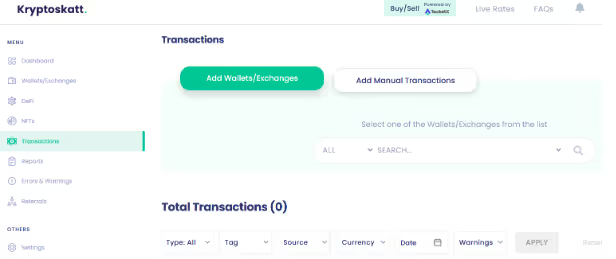.avif)
Calculate Your Crypto
Taxes in Minutes

The HMRC recognises crypto as an asset which means individuals need to pay capital gains taxes on any profit made on its disposal. To do this, HMRC has defined clear guidelines on how to calculate your crypto taxes in the UK.
In this article, we’ll discuss the laws set by HMRC for calculating your capital gains including Share Pooling, Same Day rule, and 30 Day rule. To learn more about UK taxes, refer to our UK Crypto Tax Guide.
What Is Share Pooling Crypto?
Share pooling, also called share matching, is a UK-specific cost-basis method defined by HMRC to calculate crypto taxes for similar tokens. Instead of calculating the capital gain or loss for individual transactions, the same type of crypto is kept in a ‘pool’ (or section 104 pool).
The cost basis for each crypto token acquired at different points of time goes into the pool to create the ‘pooled allowable cost’. This is used to calculate the capital gains or losses when you sell some of the assets in the pool.
Please note that the HMRC describes NFTs as “separately identifiable” so they are not pooled.

How To Calculate Capital Gains Using Share Pooling Rules?
To determine crypto taxes using a share pooling cost basis, you need to consider the following three rules.
- The Same Day Rule
- The 30 Day Rule, also called Bed and Breakfasting Rule
- Section 104 Holding
The Same Day Rule
When you dispose and acquire tokens on the same day, you will use the average cost basis of all the tokens purchased on that day and the average sale price to calculate your capital gains or loss.
- All the acquired tokens are treated in a single transaction
- All the token disposals are treated in a single transaction
Your cost basis is the average of all the purchases you make on the day The acquired tokens are matched with the disposed of quantity as much as possible to avoid sending them into the section 104 pool.
If the disposed of tokens exceeds the acquired quantity, the excess tokens will be considered for the second rule – the 30 day rule.
Let’s consider an example to understand this better.
Noah acquired 1.2 bitcoin for £7000 in November 2019 and 0.3 bitcoin for £2300 in April 2020.
It is considered that Noah has a single section 104 holding of (1.2+0.3) = 1.5 bitcoin and a total allowable cost of £9300 for the pool.
Average cost basis: 9300/1.5 = £6200/ bitcoin
Now, Noah sells 0.5 bitcoin for £5000 in October 2022. He buys back 0.3 bitcoin on the same day for £2900. Here, the Same Day rule gets applied.
The acquired tokens are matched with the disposed of quantity first and then applied to the shared pool.
Cost basis (of acquired tokens falling under same day rule): £2900
Cost basis (of remaining disposed of tokens): 0.2 * 6200: £1240
Total cost basis (considered for calculating capital gain or loss): £ (2900+ 1240) = £4140
So, the capital gains realized (Selling price - cost basis): £ (5000 - 4140) = £860
The 30 Day Rule (or, Bed and Breakfasting Rule)
When you dispose of tokens and then acquire the same type, in the same quantity within the next 30 days, you will calculate the cost basis of the disposed of tokens using the FIFO method. This is also called the ‘bed and breakfasting’ rule.
This rule prevents investors from using the crypto ‘wash sale’ – where the crypto is sold at a lower price to realize a capital loss but is repurchased to maintain the asset quantity while avoiding crypto taxes.
If the disposal quantity is more than the number of acquired tokens within 30 days, the remaining assets are considered in the section 104 rule.
Let’s use the above example of Noah to understand this.
Noah purchases 1.2 bitcoin for £7000 in November 2019 and 0.3 bitcoin for £2300 in April 2020.
So, Noah has a single section 104 holding of (1.2+0.3) = 1.5 bitcoin and a total allowable cost of £9300 for the pool.
Average cost basis: 9300/1.5 = £6200/ bitcoin
Now, Noah sells 0.5 bitcoin for £5000 in October 2022. He buys back 0.3 bitcoin on the same day for £2900. Here, the Same Day rule gets applied.
The acquired tokens are matched with the disposal quantity before sending the excess to the 30-day rule or the section 104 pool, whichever is applicable.
Cost basis (of acquired tokens falling under same day rule): £2900
However, he also purchases 0.1 bitcoin for £850 10 days later. This transaction falls under the 30 day rule.
Cost basis (of acquired tokens falling under 30 day rule): £850
Cost basis ( of remaining 0.1 bitcoin falling under s104 pool): (0.1 * 6200) = £620
Total cost basis: (2900+850+620) = £4370
So, the capital gains earned by Noah: (5000 - 4370) = £630
Section 104 Holding Rule
Under this rule, you should calculate the cost basis of a given pool of assets using the average cost basis method. This is then used to calculate your capital gains or losses.
- To calculate the average cost basis of the pooled assets, find out the total cost basis of all the crypto before disposal and divide it by the number of the assets
- To calculate your sale price, multiply the average cost basis by the number of disposed of crypto
- Use it to calculate your capital gain or loss for the given crypto pool
The s104 pool is the total of all the crypto assets that doesn’t fall under the same day or 30 day rule. The same crypto assets are considered to be in the same pool.
Summarising The Share Pooling Process
Here’s the step-by-step process as defined by HMRC:
- If you dispose of crypto and then buy it back, in the same quantity, within the next 30 days, then the same day rule is applied first if applicable
- The remaining acquired tokens to which the 30 day rule applies are matched to the disposed of tokens and don’t go into the s104 pool
- If the quantity of tokens acquired exceeds the disposed of quantity in the next 30 days, the excess goes into the section 104 pool.
How Kryptos Can Help Calculate Your UK Crypto Taxes
While the above-stated rules look straightforward, keeping track of multiple transactions for different asset pools can quickly turn complicated.
Kryptos’s crypto tax calculator automatically does this all for you in a matter of minutes.
All you need to do is:
- Go to the settings and choose your base currency, country and cost basis method.

- Import your transactions and let Kryptos do the calculations for you

You can view and manage your DeFi portfolio to gain better clarity on your tax position, and generate UK-specific reports that comply with HMRC rules.
To learn more, Sign Up on Kryptos for free now.
FAQs
1. What is the 30-day rule in crypto?
The 30-day rule applies when you sell crypto and buy the same assets back within 30 days. Here, you will calculate the cost basis of the disposed of tokens using the FIFO method.
2. What is the Section 104 holding rule?
Under this rule, you should calculate the cost basis of a given pool of assets using the average cost basis method. It is then used to calculate your capital gains or losses. The s104 pool is the total of all the crypto assets that don’t fall under the same-day or 30-day rule.
3. What is the same-day crypto rule?
When you dispose of and acquire tokens on the same day, you will use the average cost basis of all the tokens purchased on that day and the average sale price to calculate your capital gains or loss. The disposal crypto amount is matched with the purchased amount to determine gains or losses, before applying the Section 104 holding to the excess tokens.
All content on Kryptos serves general informational purposes only. It's not intended to replace any professional advice from licensed accountants, attorneys, or certified financial and tax professionals. The information is completed to the best of our knowledge and we at Kryptos do not claim either correctness or accuracy of the same. Before taking any tax position / stance, you should always consider seeking independent legal, financial, taxation or other advice from the professionals. Kryptos is not liable for any loss caused from the use of, or by placing reliance on, the information on this website. Kryptos disclaims any responsibility for the accuracy or adequacy of any positions taken by you in your tax returns. Thank you for being part of our community, and we're excited to continue guiding you on your crypto journey!
| Step | Form | Purpose | Action |
|---|---|---|---|
| 1 | 1099-DA | Reports digital asset sales or exchanges | Use to fill out Form 8949. |
| 2 | Form 1099-MISC | Reports miscellaneous crypto income | Use to fill out Schedule 1 or C. |
| 3 | Form 8949 | Details individual transactions | List each transaction here. |
| 4 | Schedule D | Summarizes capital gains/losses | Transfer totals from Form 8949. |
| 5 | Schedule 1 | Reports miscellaneous income | Include miscellaneous income (if not self-employment). |
| 6 | Schedule C | Reports self-employment income | Include self-employment income and expenses. |
| 7 | Form W-2 | Reports wages (if paid in Bitcoin) | Include wages in total income. |
| 8 | Form 1040 | Primary tax return | Summarize all income, deductions, and tax owed. |
| Date | Event/Requirement |
|---|---|
| January 1, 2025 | Brokers begin tracking and reporting digital asset transactions. |
| February 2026 | Brokers issue Form 1099-DA for the 2025 tax year to taxpayers. |
| April 15, 2026 | Deadline for taxpayers to file their 2025 tax returns with IRS data. |
| Timeline Event | Description |
|---|---|
| Before January 1, 2025 | Taxpayers must identify wallets and accounts containing digital assets and document unused basis. |
| January 1, 2025 | Snapshot date for confirming remaining digital assets in wallets and accounts. |
| March 2025 | Brokers begin issuing Form 1099-DA, reflecting a wallet-specific basis. |
| Before Filing 2025 Tax Returns | Taxpayers must finalize their Safe Harbor Allocation to ensure compliance and avoid penalties. |
| Feature | Use Case Scenario | Technical Details |
|---|---|---|
| Automated Monitoring of Transactions | Alice uses staking on Ethereum 2.0 and yield farming on Uniswap. Kryptos automates tracking of her staking rewards and LP tokens across platforms. | Integrates with Ethereum and Uniswap APIs for real-time tracking and monitoring of transactions. |
| Comprehensive Data Collection | Bob switches between liquidity pools and staking protocols. Kryptos aggregates all transactions, including historical data. | Pulls and consolidates data from multiple sources and supports historical data imports. |
| Advanced Tax Categorization | Carol earns from staking Polkadot and yield farming on Aave. Kryptos categorizes her rewards as ordinary income and investment income. | Uses jurisdiction-specific rules to categorize rewards and guarantee compliance with local tax regulations. |
| Dynamic FMV Calculation | Dave redeems LP tokens for Ethereum and stablecoins. Kryptos calculates the fair market value (FMV) at redemption and during sales. | Updates FMV based on market data and accurately calculates capital gains for transactions. |
| Handling Complex DeFi Transactions | Eve engages in multi-step DeFi transactions. Kryptos tracks value changes and tax implications throughout these processes. | Manages multi-step transactions, including swaps and staking, for comprehensive tax reporting. |
| Real-Time Alerts and Updates | Frank receives alerts on contemporary tax regulations affecting DeFi. Kryptos keeps him updated on relevant changes in tax laws. | Observe regulatory updates and provide real-time alerts about changes in tax regulations. |
| Seamless Tax Reporting Integration | Grace files taxes using TurboTax. Kryptos integrates with TurboTax to import staking and yield farming data easily. | Direct integration with tax software like TurboTax for smooth data import and multi-jurisdictional reporting. |
| Investor Type | Impact of Crypto Tax Updates 2025 |
|---|---|
| Retail Investors | Standardized crypto reporting regulations make tax filing easier, but increased IRS visibility raises the risk of audits. |
| Traders & HFT Users | To ensure crypto tax compliance, the IRS is increasing its scrutiny and requiring precise cost-basis calculations across several exchanges. |
| Defi & Staking Participants | The regulations for reporting crypto transactions for staking rewards, lending, and governance tokens are unclear, and there is a lack of standardization for decentralized platforms. |
| NFT Creators & Buyers | Confusion over crypto capital gains tax in 2025, including the taxation of NFT flips, royalties, and transactions across several blockchains. |
| Crypto Payments & Businesses | Merchants who take Bitcoin, USDC, and other digital assets must track crypto capital gains for each transaction, which increases crypto tax compliance requirements. |
| Event | Consequences | Penalties |
|---|---|---|
| Reporting Failure | The tax authorities can mark uncontrolled revenues and further investigate. | Penalty fines, interest on unpaid taxes and potential fraud fees if they are deliberately occurring. |
| Misreporting CGT | Misreporting CGT Error reporting profits or losses can trigger the IRS audit. | 20% fine on under -ported zodiac signs, as well as tax and interest. |
| Using decentralized exchanges (DEXs) or mixers without records | The IRS can track anonymous transactions and demand documentation. | Possible tax evasion fee and significant fine. |
| Disregarding Bitcoin mining tax liabilities | Mining reward is considered taxable income, and failure of the report can be regarded as tax fraud. | Further tax obligations, punishment and potential legal steps. |
| Foreign crypto holdings: Non-disclosure | Foreign-accepted crypto FATCA may be subject to reporting rules. | Heavy fines (up to $ 10,000 per fracture) or prosecution for intentional non-transport. |
File Your Crypto Tax in Minutes







.avif)
